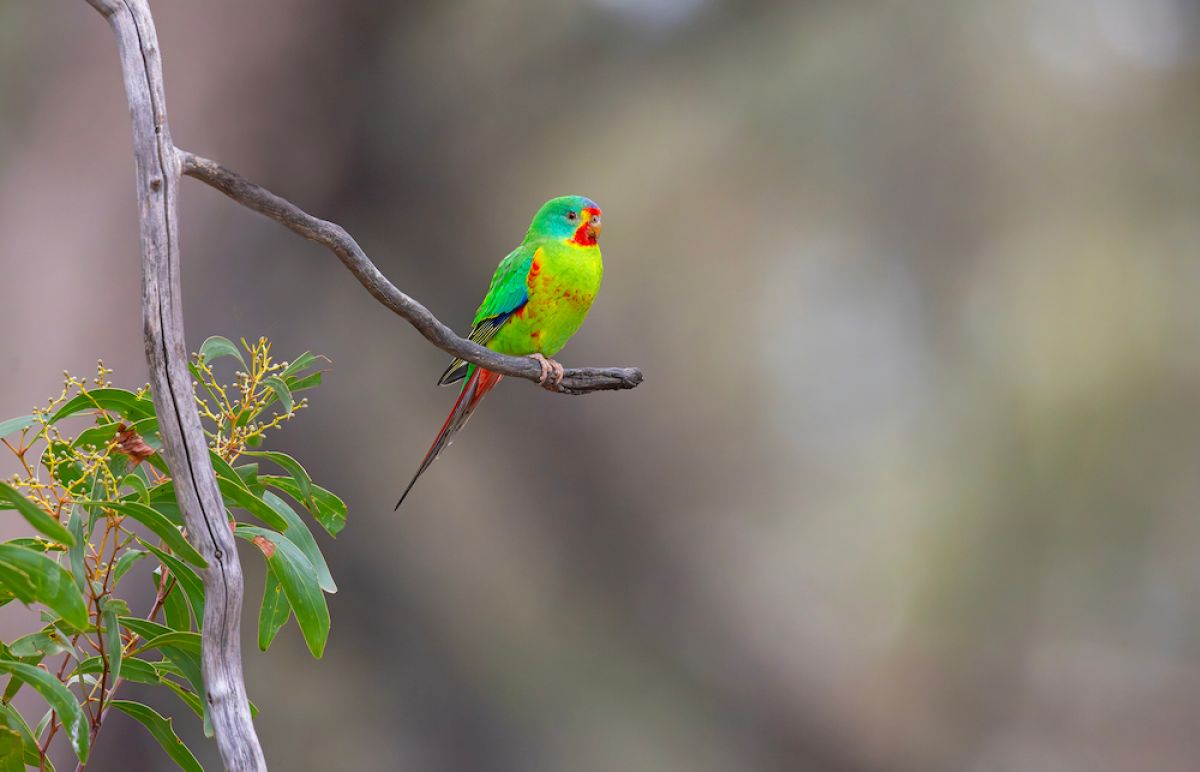A remarkable event is unfolding on the southern outskirts of Bendigo, where a flock of more than 600 critically endangered Swift Parrots has been observed. While this event can be considered nationally significant, it’s not necessarily a cause for celebration, as the species is still in decline. It is estimated there are approximately 750 birds left in the wild.
A species on the brink
While this latest mass flock of Swift Parrots, affectionately known as swifties, is one of the largest flocks ever observed on the mainland, it is not a sign of recovery. The species is still in rapid decline due to a range of ongoing threats, including commercial native forest logging, urban development, and predation by introduced Sugar Gliders in Tasmania.
The Swift Parrot is a migratory and highly nomadic species, reliant on suitable, productive habitats for food resources. The parrots predominantly forage on nectar and lerp (a waxy, sugar-rich secretion by leaf-borne insects known as Psyllids) sourced from a few select eucalypt species.
Beau Meney is a Woodland Bird Project Coordinator with Birdlife Australia, where he works closely on the species.
‘Swift Parrots breed in Tasmania during the spring and summer months before migrating to the south-eastern mainland for the cooler months.’
‘On the mainland swifties rely on a variety of food sources across a broad geographical area spanning large parts of Victoria, NSW, ACT and into south-east Queensland.’
‘This formation of such a large flock is likely influenced by a combination of factors including, ongoing dry conditions in Victoria and southern NSW, and reduced food availability at the time’ Beau said.
The overlooked habitat
The flock observed in Bendigo are primarily feeding on flowering Yellow Gum – a key feed tree for the Swift Parrot.
Adrian Martins is Manager of Natural Environment Programs with the Department of Energy, Environment and Climate Action and has spent hours observing this event.
‘While a flock of this size has been quite a spectacle, the local flowering conditions among eucalypts has been ‘unremarkable’ in terms of the intensity of blossom. Which highlights the importance of protecting and retaining habitat, even if it appears unremarkable’ Adrian said.
Important feed tree species can be unproductive some years, meaning Swifties need to search further for trees suitable for feeding. This may restrict the birds to a particular region where conditions are favourable.
The species rely on a network of different habitat types, small, seemingly insignificant patches can be crucial for supporting the bulk of the wild population during lean times.
The power of roadsides and your backyard
Trees on private land and along roadsides play an important role in sustaining biodiversity.
Chris Tzaros, a wildlife ecologist and past coordinator of the Swift Parrot Recovery Program, has been studying Swift Parrots since he was a child growing up in Bendigo’s Strathfieldsaye. He encountered a swiftie as a child, which prompted him to learn more in the school library, sparking a life-long interest.
‘The vegetation on private land and roadsides is playing a key role during this event. Around Bendigo in parks and reserves, there has been very little flowering and lerp production – two key food sources for Swift Parrots. The retained patches of flowering native eucalypts outside the protected areas are proving essential to the swifties,’ Chris said.
‘Public parks and reserves are great, but often it’s the private land - the fertile lower country and roadsides and creek lines that’s needed, especially in dry times when resources are limited’ Chris said.
While it is important to continue protecting public land and reserves, these places may not always have sufficient food available. Conservation across land tenure is necessary to secure biodiversity.
We all have a role to play
We can all support and help secure native biodiversity by being aware of important habitat features and values, protecting existing habitats that remain, and restoring and recreating habitats in areas where they have been removed or degraded.
- Learn more about the habitats and tree species that are native to your area. Get to know them and the wildlife species that rely on them.
- Protect native species on your property. Don’t cut down trees without seeking the required authority before taking any action.
- When buying firewood, know where it comes from to avoid inadvertently supporting illegal firewood theft.
- Plant locally native plant species on your property, and be sure to include a range of shrub species into your plantings.
- Contribute to the database Birdata and our collected knowledge of swifties. Data entered in Birdata are provided to the Victorian Biodiversity Atlas. For more information, visit: Birdata Birdlife.



Page last updated: 05/07/25